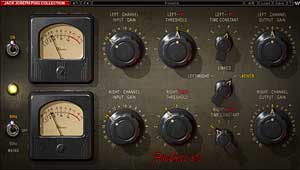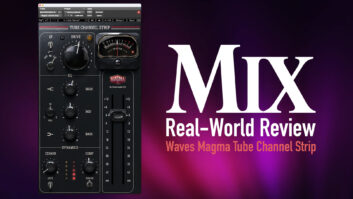
The PuigChild 670 mono version has controls for input gain, threshold, six different time constants and output level.
Waves Ltd. has based this set of plug-ins on classic equipment with emulations of desired and rare vintage tube processors dating back to the 1950s. The Jack Joseph Puig Collection has PuigChild, plug-ins based on the Fairchild 670 and 660 limiters, and PuigTec, mono and stereo versions of the Pultec EQP-1A and MEQ-5 program equalizers. Waves, along with producer/engineer/mixer Jack Joseph Puig, spent more than three years developing these processors. They are based on examples from Puig’s vast personal collection of heirloom vintage audio equipment.
PUIGCHILD
The 670 and 660 mono versions have controls for input gain, threshold, six different time constants and output level. Time constants are fixed sets of combined attack and release settings. PuigChild replaces the Fairchild 670’s arcane AGC knob with a switch for unlinked, regular L/R stereo linkage (left channel controls the right) or lateral/vertical operating modes.
In lateral/vertical mode, the PuigChild emulates a “back in the day” use of the 670 for obtaining maximum loudness/play time in stereo vinyl-disc mastering by splitting the mid or mono component of the stereo signal off to the top channel and the side, or L/R stereo information over to the bottom channel. The PuigChild includes an encoder/decoder that allows separate limiting of M/S signals and conversion back to conventional stereo.
PUIGTECH EQP-1A AND MEQ-5
The PuigTec EQP-1A copies the original Pultec starting with a shelving section cmprising four low, peak/cut frequencies from 20 Hz to 100 Hz and separate 18dB boost and cut controls. Next is an HF peaking section with seven frequency choices from 3 kHz to 16 kHz and up to 20 dB of boost, plus a sharp/broad Q control. Lastly, there is a separate high-shelving cut filter with 5, 10 or 20kHz frequency choices and up to 20 dB of attenuation.
Designed after the EQP-1A and as a complimentary processor, the MEQ-5 is a 3-band equalizer with five low-shelving peak choices from 200 Hz to 1 kHz and up to 10dB boost. There are 11 “dip” frequencies from 200 Hz to 7 kHz with up to 10dB attenuation and a high-shelving filter with five peak frequencies from 1.5k Hz to 5 kHz with up to 10 dB of boost.
Like the Pultecs, both PuigTecs have the ability to boost and cut at the same time and at the same frequency, producing a “distorted” but desirable and colorful resonant shelving curve.
All JJP plug-ins complete their emulations with the original controls and nomenclature, but each add a Mains selector switch to enable/disable the addition of either 50Hz or 60Hz AC line hum mixed with low-level background noise common to old tube-based gear.
BACK TO THE BEAUTIFUL
These plug-ins’ GUIs are immediately beautiful and impressively inviting—artistically surreal renditions of the original front panels that popped off my Pro Tools’ screen.
I started with a great-sounding female lead vocal where the recording was not distorted, not over EQ’d, not over compressed, and had a great performance and general intonation. I would fix all that!
I “double-slammed” the vocal track with two PuigChild 660s in series followed by a PuigTec EQP-1A. PuigChild number 1 used the fastest time constant number 1 to catch peaks quickly for up to 10dB of compression. PuigChild number 2 used the slower position number 4 for an overall leveling effect. The following PuigTec EQP-1A was set to 10 at 7 kHz with bandwidth at 11 (Broad). All Mains switches were off.
The result was a very present and close vocal sound as if she was singing in your ear. You could hear all her nuances—consonant fricatives and spirants—so well that she sounded more emotive, angst-filled and urgent. This was in spite of the din from the track’s “wire choir” of a dozen electric guitars. She was totally intelligible but not overpowering loud over the track.
The PuigChild works great for electric guitars—there is a noticeable loss of bass and a nearly imperceptible loss of high frequencies when it is inserted. This works out well on vocals and guitars as there is usually a little low-frequency “mud” anyway, but subsequent equalization should take place while the PuigChild is inserted.
For the same reasons, I liked the PuigChild on certain boomy bass guitars and kick drums. It’s not a clinically perfect limiter and not my fave as a stereo bus limiter; it’s too colorful even though I found the PuigChild’s coloration and idiosyncratic charm its main attractions.
I tried the M/S mode on a stereo backing vocal stack. The melody tracks were center-panned and too loud, and by adjusting compression amount and level of the mid signal, I was able to subdue them for a better blend with the harmony tracks.
Not for surgical use, the PuigTec EQP-1A is a brilliant touch-up EQ—it sounds smoother and bigger even with large boosts. It sounds great inserted with everything set to zero, like the PuigChild, expect a sound change when first inserting either the EQP-1A or MEQ-5. The PuigTecs add an output gain control and handy VU meter, but I wish they had an input level control as superhot levels will sometimes overload and light up the peak LED.
I used the EQP also on electric guitars to boost 100 Hz and add a touch of 3kHz broad for cut. The MEQ-5 makes a good vocal equalizer because you can “dial in” the all-important midrange. I found by boosting and cutting at two frequencies between 1.5 kHz and 5 kHz at the same time, I got a very unique coloration.
SMOOTH OPERATORS
The JJP Collection contains the best plug-in versions I’ve heard of these old units. Thinking more right-brain than left-brain or analytically, I went to them to build moods rather than as specific problem-solvers. They sound like the originals, work flawlessly in my DAW ,and perfectly emulate the imprecision and the colorfully quaint variability of audio gear from an era long ago.
Company: WAVES
Product: JJP Collection
Website:waves.com/Content.aspx?id=7306
Price: $1,600, TDM; $800, Native
Pros: Super-realistic, great-sounding emulations of classic processors, warts and all. The PuigChild includes M/S stereo capabilities.
Cons: Loss of bass is part of the emulation and not switchable on the PuigChild. The PuigTecs could use an input level control to keep hot levels from overloading them.
Support: TDM, RTAS, VST, Audio Units on PC or Mac; 24-bit/192kHz






